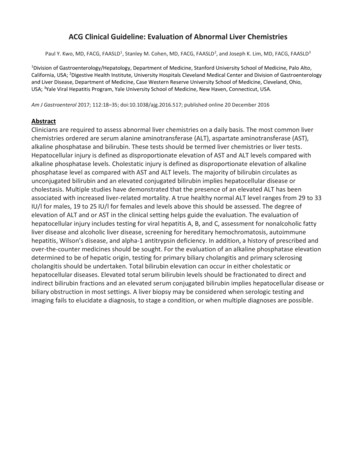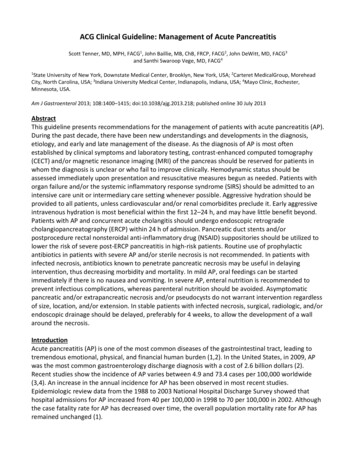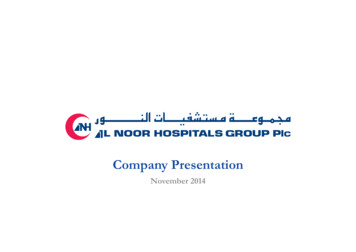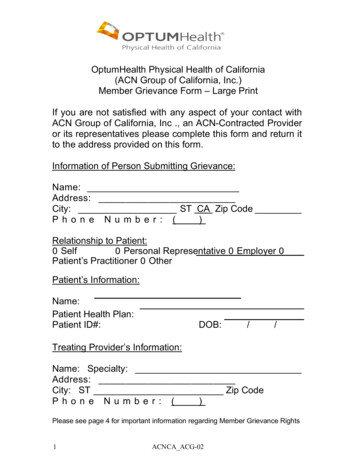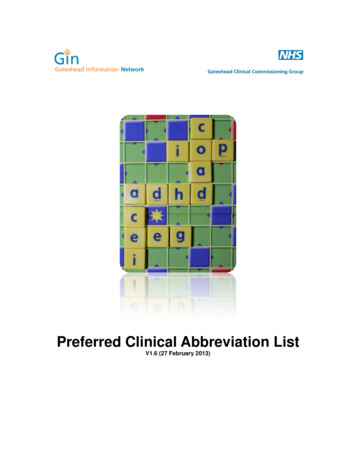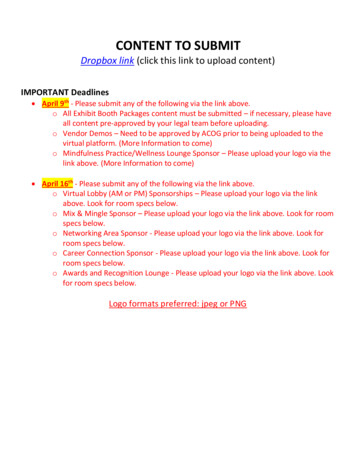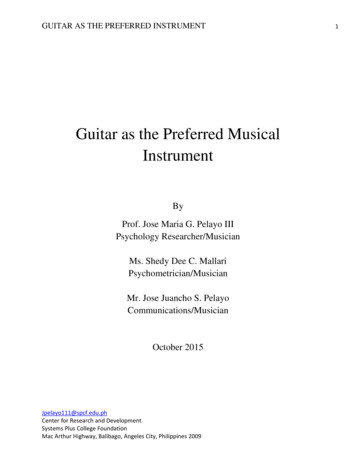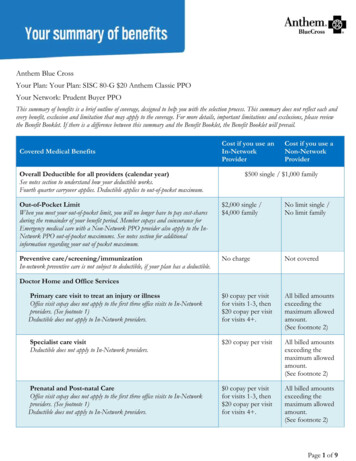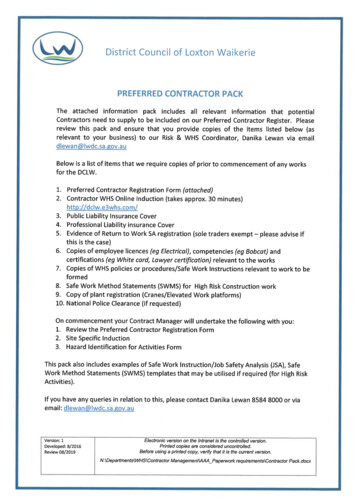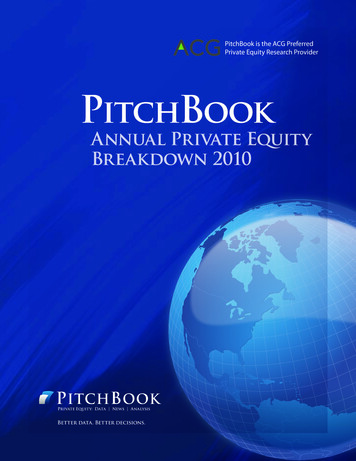
Transcription
PitchBook is the ACG PreferredPrivate Equity Research ProviderPitchBookAnnual Private EquityBreakdown 2010Private Equity: Data News AnalysisBetter data. Better decisions.
The PitchBook DifferencePrivate Equity: Data News AnalysisBetter Data. Better decisions.Table Of ContentsPrivate Equity Deal Flow Overview . 3Deal Details . 4Deal Flow By Industry . 5Deal Flow By Industry (Cont’d). 6Deal-Related League Tables . 7Private Equity Exits Overview . 8Private Equity Exits Details . 9Private Equity Fundraising Overview . 10Fundraising League Tables . 11Private Equity Fund Returns Overview . 12About PitchBook. 13COPYRIGHT 2010 by PitchBook Data, Inc. All rights reserved. No part of this publication may be reproduced in any form or by any means – graphic, electronic, or mechanical, including photocopying, recording,taping, and information storage and retrieval systems – without the express written permission of PitchBookData, Inc. Contents are based on information from sources believed to be reliable, but accuracy and completeness cannot be guaranteed. Nothing herein should be construed as any past, current or future recommendation to buy or sell any security or an offer to sell, or a solicitation of an offer to buy any security. Thismaterial does not purport to contain all of the information that a prospective investor may wish to considerand is not to be relied upon as such or used in substitution for the exercise of independent hbook.com
The PitchBook DifferencePrivate Equity: Data News AnalysisBetter Data. Better decisions.Private Equity Deal FlowU.S. private equity deal flow for 2009 was down 50% from 2008 and 65% from 2007 to 979 completed deals, a level not seen since 2003. Acloser look at deal activity for the year shows it was dominated by lower and middle-market deals, which accounted for over 90% of thedeal flow. Total invested capital declined from 205 billion in 2008 to 43 billion in 2009. 75% of the 162 billion difference is due to thedrop in deals over 1 billion, a direct result of the credit crisis. However, these larger investments did begin to recover somewhat in thesecond half of 2009 with four completed investments over 1 billion versus just one in the first half of the year. PE investment seemed toturn a corner in the fourth quarter with deal flow increasing for the first time in a year and total capital invested jumping to its highestquarter total of the year at 15.3 billion. It was also a slow year for exits with only 224 liquidity events, the least since 2002. Leading thedecline were exits through sales to strategic acquirers, which were 54% less than in 2008 and 65% less than in 2007. One bright spot inthe exit market was the return of IPOs, with 25 completed PE-backed offerings during the year.U.S. Private Equity Deal Flow - YrThe first three quarters of 2009 were extremely difficult for privateequity on all fronts. Investors spent more time with their portfolios,bankers, and advisors focusing on how to survive rather than thrive.However, in the fourth quarter, debt markets began to thaw anddeal and exit flow increased.The coming year will continue to provide plenty of challenges forprivate equity investors, but if the economy continues to stabilizeand debt becomes more available, 2010 should prove to be a morefruitful year than 2009.Source: PitchBookU.S. Private Equity Deal Flow - QtrSource: hbook.com
The PitchBook DifferencePrivate Equity: Data News AnalysisBetter Data. Better decisions.Median Deal Amount by YearDeal Activity by Geogr aphySource: PitchBookSource: PitchBookThe median deal amount dropped slightly in 4Q to 45 millionbut was still significantly better than the 20 million in 1Q and2Q. In the second half of 2009, the median deal amount roseto 50 million—a level comparable to pre-crash medians—signaling that middle market valuations are stabilizing and thedeal landscape is regaining some semblance of normalcy.Despite an overall drop in deal flow by 50%, the geography ofU.S. private equity investment changed very little from 2008.The largest change for any region was the Southeast, whichincreased its share by 3 percentage points. The state with themost PE-related investments was California with 126 deals,followed by Texas with 97 and New York with 83.Percent of PE Investment(Total Amount) by Deal SizePercent of PE Tr ansactions(Count) by Deal SizeSource: PitchBookSource: PitchBookPrivate equity deals in the lower and middle-market (under 250 million) continued their upward trend, accounting for86% of the deal flow in 2009. The chart above shows thatprivate equity does not consist solely of mega-deals, but is infact dominated by much smaller deals in the middle-market.www.pitchbook.comLarger deals ( 1 billion and above) continued their retreatfrom the high-water mark of 2007 when they accounted for78% of total capital invested. The breakdown of investment bydeal size shows that 2009 was closer to 2004, with a moreeven distribution and a much bigger middle-market presence.[4]877-267-5593demo@pitchbook.com
The PitchBook DifferencePrivate Equity: Data News AnalysisBetter Data. Better decisions.Business Products & Services (B2B)The Business Products and Services (B2B) industry, whichincludes Commercial Products, Commercial Services, andTransportation sub-sectors, saw 80 completed U.S. dealsin 4Q and 158 in the 2H09. For 4Q 2009, the total dealcount came in just above the 2009 B2B average of 78deals per quarter. Year-over-year, the 312 B2B deals in2009 as compared to the 686 in 2008 represents a 55%decline in deal activity. The fact that the amount of dealsper quarter was tightly clustered around the average is atestament to private equity’s relatively stable investmentin the industry during 2009.Source: PitchBookConsumer Products & Services (B2C)The Consumer Products and Services (B2C) industry,which includes Apparel, Consumer Durables and NonDurables, Media, Restaurants, Hotels, Leisure, Retail,Transportation, and Non-Financial Services sub-sectors,saw U.S. deal count fall to 46 deals from 48 over the lastquarter of 2009, representing a 4% quarterly decline. For4Q 2009, the total deal count came in at well below the2009 B2C average of 58 deals per quarter. Throughoutthe year, there was a steady and significant decline in thenumber of B2C deals per quarter as private equityinvestors turned to industries less impacted by themeltdown.Source: PitchBookInformation TechnologyThe Information Technology (IT) industry, which includesCommunication and Networking, IT Hardware, Semiconductors, IT Services, and Software sub-sectors, saw anaverage of 34.25 deals per quarter. IT represented 14% oftotal PE deal flow, the highest ever for the industry.Comparing this year to last year, the 137 IT deals in 2009versus the 183 in 2008 represented a 25% decline inactivity, half the decrease of PE investment overall. Thetop investors in the industry for 2009 were Marlin EquityPartners, The Carlyle Group, Thoma Bravo and WarburgPincus with four deals apiece.Source: hbook.com
The PitchBook DifferencePrivate Equity: Data News AnalysisBetter Data. Better decisions.HealthcareThe Healthcare industry, which includes Devices andSupplies, Technology Systems, Pharmaceuticals andBiotechnology, and Services sub-sectors, saw U.S. dealcount fall to 31 from 35 over the last quarter of 2009,representing an 11% quarterly decline. For 4Q 2009, thetotal deal count came in at just under the 2009 Healthcare average of 31.25 per quarter. When comparing thisyear to last year, the 125 Healthcare deals in 2009 ascompared to the 233 in 2008 represents a 46% decline inyear-over-year activity. The median deal amount for theindustry fell significantly in 2009 to 18.5 million, a 60%decline from 2008 and a 71% drop from 2007.Source: PitchBookEnergyThe Energy industry, which includes Equipment, Exploration, Production and Refining, Services, and Utilitiessub-sectors, saw U.S. deal count rise in 2H09 to 39 from30 in 1H09, representing a 30% increase. On an annualbasis, deal flow plummeted in 2009 by 61% to 69 from176 in 2008. The most active energy sub-sector in 2009was Exploration, Production & Refining with 31 deals.Investment in Energy was clearly affected by the fall inenergy prices, but as they continue to stabilize, look forPE’s interest in this industry to rebound.Source: PitchBookFinancial ServicesThe Financial Services industry, which includes CapitalMarkets Institutions, Commercial Banks, and Insurancesub-sectors, saw U.S. deal count skyrocket to 19 from 8over the last quarter of 2009, representing a 137.5%quarterly increase. However, for 4Q 2009, the total dealcount came in at just above the 2009 B2B average of 17deals per quarter, a number which was brought down byan unusually slow third quarter. Year-over-year, the 68Financial Services deals in 2009 as compared to the 137in 2008 represents a 50% drop in activity.Source: hbook.com
The PitchBook DifferencePrivate Equity: Data News AnalysisBetter Data. Better decisions.Most Active Private EquityInvestors in 2009Most Active Private EquityService Providers in 2009By Number of InvestmentsBy Number of Deals ServicedInvestor NameDeal CountParthenon Capital PartnersThe Riverside CompanyThe Carlyle GroupOaktree Capital ManagementPlatinum EquityKohlberg Kravis RobertsSun Capital PartnersWarburg PincusThe Blackstone GroupGTCR Golder RaunerVeronis Suhler StevensonApollo Investment ManagementBain CapitalGolden Gate CapitalH.I.G. CapitalMarlin Equity PartnersMillennium Technology VenturesSterling PartnersSummit PartnersThoma BravoWelsh, Carson, Anderson & StoweAmerican Securities Capital PartnersAngelo Gordon & CompanyFalconhead CapitalHellman & FriedmanHuntington CapitalJ.F. Lehman & CompanyMilestone PartnersProvidence Equity PartnersWayzata Investment PartnersAdvent InternationalAmerican CapitalBanc of America Capital InvestorsCerberus Capital ManagementClearview CapitalGeneral AtlanticGraham PartnersHart CapitalKPS Capital PartnersNavigation Capital PartnersPegasus Capital AdvisorsPerseusPfingsten PartnersRoundTable Healthcare PartnersStonington PartnersTPG CapitalTop Law Firms in Private 55555555Jones DayKirkland & EllisLatham & WatkinsShearman & SterlingSullivan & CromwellSkadden, Arps, Slate, Meagher & FlomSimpson Thacher & BartlettBlank RomeWachtell Lipton Rosen & KatzPaul Weiss Rifkind Wharton & Garrison1 by counsel provided on transactionsTop Investment Banks & Advisors2Houlihan Lokey Howard & ZukinGoldman SachsJP MorganAlvarez & MarsalLazard Middle MarketMoelis & CompanyHarris Williams & Co.Morgan StanleyCitigroupWilliam Blair & CompanyJefferies & CompanyBank of America Merrill Lynch2 by number of advisory roles in transactionsTop Lenders in Private Equity3Bank of AmericaWells FargoGE CapitalPNC Financial Services GroupCIT GroupGolub CapitalBabson Capital PartnersFifth Third BankU.S. BancorpWells Fargo FoothillTriState Capital BankWachovia BankMadison Capital Funding3 by number of financings providedSource: PitchBookSource: hbook.com
The PitchBook DifferencePrivate Equity: Data News AnalysisBetter Data. Better decisions.Private Equity Exits - 2009Exits were few and far between for U.S. private equity investors in 2009, totaling only 161, which represents a 50% drop from 2008and a 67% decline from 2007. This decline was attributable to a number of credit crisis and recession-related factors, includingdeclines in valuations tied to the public markets, an all but shut IPO market, poor portfolio company performance, a lack ofavailable leverage for all investors, and a limited availability of capital for corporate acquirers. As these effects began to ease in2H09, exit activity increased by 33% over 1H09, led by 19 IPOs in 4Q. PE firms are also currently feeling a great deal of pressurefrom their limited partners to provide distributions to help ease liquidity issues and to fund capital calls. Still many investors optedinstead to focus on improving portfolio company balance sheets and performance in preparation for better exit opportunities in2010 and 2011.The biggest impact on 2009 exit activity was the 54% fall in salesU.S. Private Equity Exits (Count) by Type - Yrto strategic acquirers (corporate acquisitions) from 2008, whichaccounted for almost 75% of the drop in 2009 exit activity. Thiswas a result of the fact that many strategic acquires did not havethe spare capital or ability to raise debt for acquisitions that theyhad in previous years.The return of the IPO market was one of the most notablestories in private equity during 2009. A total of 25 companieswere taken public by PE firms during the year, raising 6.7billion. A number of these IPOs did not represent full exits butwere used as a means of raising capital to pay down debt andproviding investors with partial returns. With 49 U.S. PE-backedcompanies currently in IPO registration, 2010 will likely see moreand bigger IPOs.Source: PitchBookU.S. Private Equity Exits (Count) by Type - QtrSource: hbook.com
The PitchBook DifferencePrivate Equity: Data News AnalysisBetter Data. Better decisions.Private Equ
The PitchBook Difference Better Data. Better decisions. U.S. private equity deal flow for 2009 was down 50% from 2008 and 65% from 2007 to 979 completed deals, a level not seen since 2003. A closer look at deal activity for the year shows it was dominated by lower and middle-market deals, which accounted for over 90% of the deal flow. Total invested capital declined from 205 billion in 2008 .
